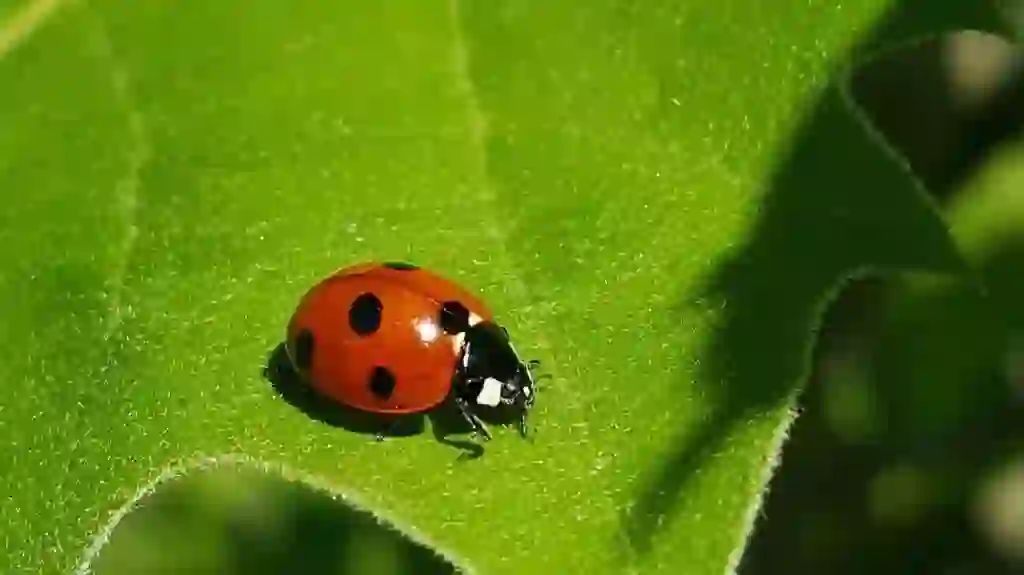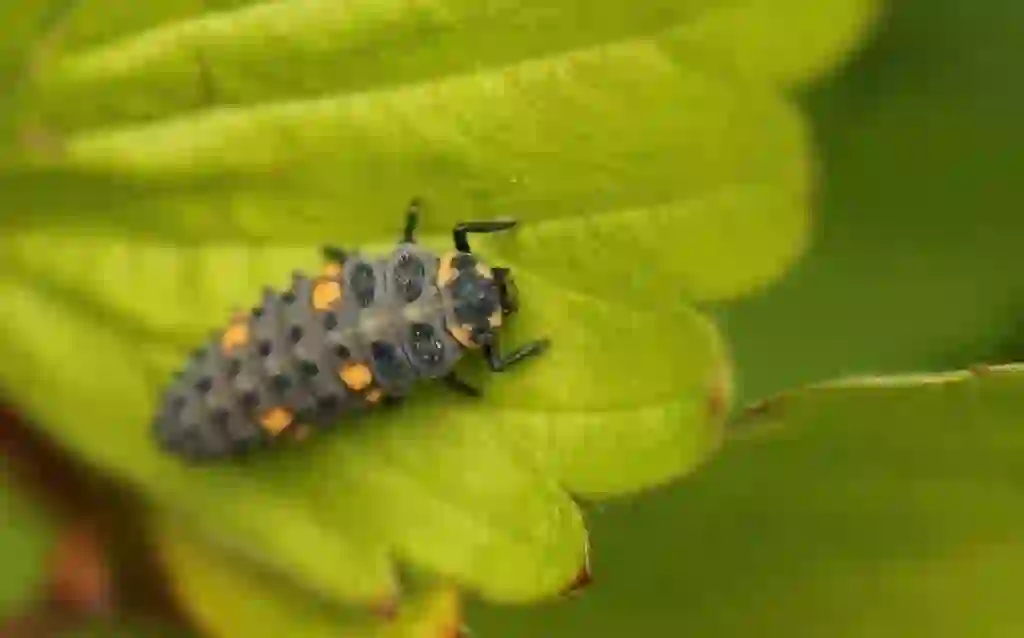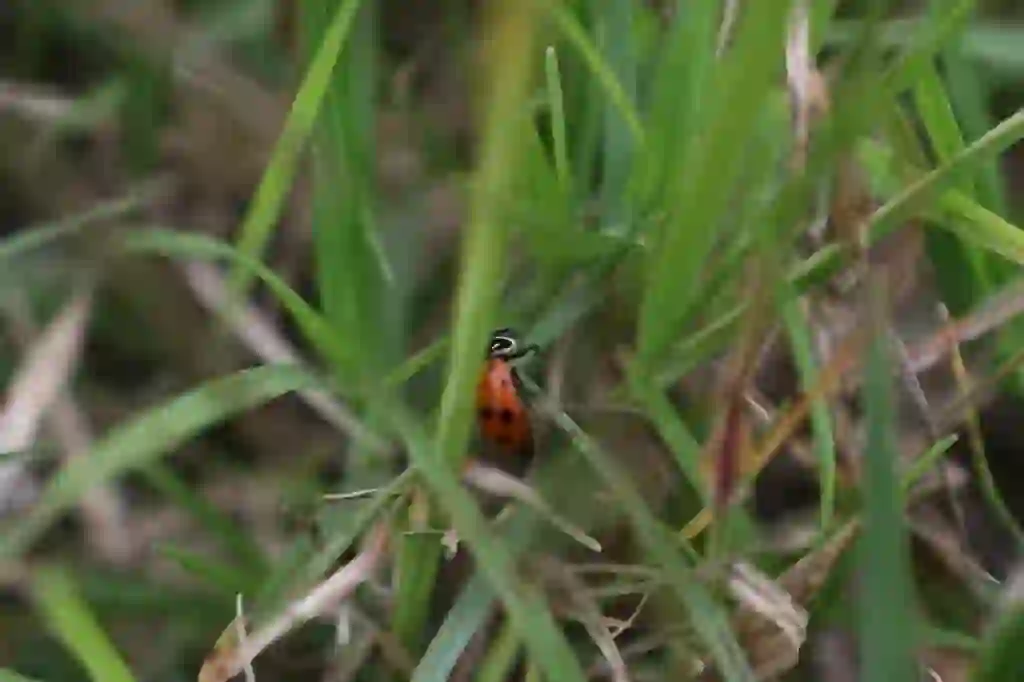
Ladybug
Ladybug
Ladybug
When you think of ladybugs, you might picture the familiar insects that appear in gardens and parks each spring. While ladybugs are cute, they can also excrete a yellow fluid that might be a bit scary. Let's take a closer look at the ecology of ladybugs.
Ladybug Basic Infomation

Class: Insecta, Order: Coleoptera, Suborder: Cucujiformia, Family: Coccinellidae
Length: A few mm to about 1 cm, Weight: 0.05g
There are said to be about 6,000 species of ladybugs worldwide.
In Japan, about 180 species have been identified, many of which are still poorly understood in terms of their ecology.
They are commonly seen in sunny grassy areas and fields around April.
Ladybugs are very small insects, with adults having a hemispherical shape and brightly colored bodies.
There is a great variety of patterns among ladybugs, with many species having polka dot patterns. The names of many ladybugs are derived from the number of spots they have.
Ladybug Q&A

What is the origin of the name Ladybug?
The ladybug is written as '天道虫' in Kanji.
It is said to derive from '天道', the path of the sun god, due to its habit of flying towards the sun.
In English, they are called 'Ladybirds', which means the bird of the Virgin Mary.
Coming from such a divine and auspicious origin, they are also said to be insects that bring happiness.
Additionally, there are three ways to translate 'ladybug' into English: 'ladybird', 'ladybug', and 'lady beetle'.
In English, 'lady' represents the Virgin Mary, which shows that ladybugs are treasured in English-speaking countries.

Why do ladybugs live there?
Ladybugs inhabit bright grasslands and forest edges.
They live where there is plenty of food, and herbivorous ones inhabit fields eating crops like potatoes.
When they find plants with many aphids, ladybugs will stay and feed there for several days.
Ladybugs prefer warm places and are also found crawling on warm ground.
Basically, all species live where there is plenty of their target food.

What do ladybugs eat?
Most species of ladybugs are carnivorous, though some are herbivorous.
Their main food is aphids.
You can find ladybugs by looking for trees like wild roses and willows that have aphids.
Some also eat plant leaves.
Species like the twenty-spotted ladybug and the twice-stabbed ladybug eat leaves of plants like potatoes and eggplants.
They are considered pests in fields because they devour leaves of plants in the nightshade family.
Turtle ladybugs, both larvae and adults, live by eating the leaves of plants like kudzu.

Why are ladybugs so brightly patterned?
Ladybugs have very vibrant patterns.
They stand out just by walking on grass.
Normally, insects have unnoticeable colors to avoid predators, but ladybugs use their bright colors to make birds suffer by secreting a bitter juice when eaten.
By repeatedly being eaten, birds learn that 'that insect is dangerous', instilling a sense of caution.
Thus, the flashy colors of ladybugs are a strategy to warn predators.

How do ladybugs eat aphids?
Despite their cute appearance, ladybugs eat their prey using sharp mandibles that are forked.
They bite into aphids with their sharp mandibles and suck the fluids out of their bodies.
In the case of small aphids, they are eaten whole.
Even such small ladybugs live by gnawing solid food.

How do ladybugs distinguish sex?
Ladybugs are so small that it is difficult for humans to distinguish males from females by sight.
However, ladybugs can distinguish between males and females through scent with their antennae.
If they are both males, they quickly separate, but if a male and female meet, they immediately begin mating.

Do ladybugs tremble during mating?
The male, mounted on the female, searches for the female's genitalia and inserts his genitalia into the female.
The male trembles his body from side to side while transferring sperm into the female.
With breaks in between, the trembling movement is repeated several times, and after mating, the male and female separate.

How many eggs does a ladybug lay at once?
Ladybugs lay about 20 to 40 eggs per oviposition.
Under captivity, some can lay 20 eggs daily.
The number of eggs a ladybug lays varies depending on how much aphids they eat.

Where do ladybugs lay their eggs?
Ladybugs lay their eggs under leaves or branches.
It is thought to protect the larvae from being cannibalized by other ladybugs.
Another reason is to avoid direct sunlight because the eggshells are transparent, and ultraviolet light can kill the cells that promote growth.

Are ladybug larvae grotesque?
Ladybug larvae look nothing like their adult form.
They appear as caterpillar-like creatures with no wings and a protruding abdomen, covered in spikes or thorns.
There are various forms, including those that resemble sponges with many sharp protrusions, and those covered in a waxy cotton-like secretion or with a swollen back.

How can ladybugs walk on stems and leaves?
Ladybugs can freely walk on both the upper and undersides of leaves without falling.
The reason they don't fall is due to the structure of the soles of their feet.
Their feet have many hair-like structures that spread out like trumpets, secreting a sticky substance.
This allows ladybugs to stick and walk on leaves without falling off.

What do ladybug larvae eat?
From their larval stage, ladybugs eat aphids just like the adults do.
When they find aphids, they bite into them with their large mandibles and suck out the insides.
They do not eat other insects, but they will eat their own eggs.
The smallest larvae can grow significantly by eating a single egg, and they grow faster than by eating aphids.
This cannibalistic behavior in ladybug larvae is said to be a mechanism to prevent too many ladybugs from accumulating in the same area.

How many patterns do ladybugs have?
Among ladybugs, there is a type called the common ladybug.
The seven-spotted ladybug has a characteristic red wing with seven black spots, but they all have the same pattern.
However, the common ladybug comes in various patterns of red and black.
The patterns of the common ladybug can be finely classified into over 50 types.
Broadly, they can be divided into four types: those with two red spots on a black background, those with four spots, those with twelve spots, and those with black dots on a red background.

Is the pattern of ladybugs hereditary?
The offspring of common ladybugs with different patterns from the male and female inherit two patterns each.
For example, offspring of a male with two red spots on a black background and a female with many spots on a red background may have small black spots within their red spots.
It is interesting how mating can produce ladybugs with various patterns.

Do ladybugs change color when they hibernate?
The common ladybug's spots turn red when they overwinter.
The spot color of ladybugs born in spring is orange, so it is possible to distinguish whether they have overwintered or not.

What happens to ladybugs in summer?
Seven-spotted ladybugs burrow into the roots of bushes to hibernate during summer.
Meanwhile, common ladybugs spend their time in trees and are not found in the grass.
Common ladybugs endure the summer heat in the shadows of leaves in forests and woods.

Are ladybugs and ants unfriendly?
Ants are attracted to the sweet juice secreted by aphids.
They collect this sweet juice and carry it back to their nest.
Therefore, ants dislike ladybugs that eat aphids.
Ants attack ladybugs by biting their antennae and legs, or by spraying a stinging substance called formic acid from their rears.
Ladybugs only defend themselves and do not attack.
Ants are a troublesome presence for ladybugs.

Is the yellow juice from ladybugs poisonous?
When you pinch a ladybug, it secretes a yellow juice.
This yellow juice is actually the ladybug's blood.
When ladybugs sense danger, they break the membranes in their leg joints to release this blood.
It tastes very bitter, so birds that prey on ladybugs tend to avoid eating them.
Additionally, this yellow juice contains substances that ants dislike.

Do ladybugs overwinter?
Ladybugs, which prefer warmer weather, begin preparing for hibernation as winter approaches.
Their hibernation spots include crevices in rocks, tree cavities, and gaps in the walls and ceilings of houses.
In some places, more than 10,000 ladybugs may gather tightly together to hibernate.
Gathering in groups keeps them warm and protects them from the cold and dryness of winter.

Are ladybugs pests or beneficial insects?
Ladybugs, when they swarm and gather in houses to hibernate, can be considered nuisance pests because their presence in large numbers may feel disgusting.
While ladybugs are colorful and cute, their aggregation and the secretion of yellow juice can cause discomfort to people.
However, carnivorous ladybugs like the seven-spotted ladybug play a beneficial role in protecting vegetables from aphids and other pests.
Moreover, ladybugs with an orange back with white spots or those that are entirely yellow are 'fungivorous ladybugs' that eat the fungi causing powdery mildew on vegetable leaves, thus they are beneficial insects.
Ladybugs can be seen as pests or as beneficial insects depending on the situation.

Would you like to become a part of the 'Animalbook.jp'?
Turn your knowledge into Q&A and share it with the world. ※Publication will be activated after purchase. Let's share information together!
Ladybug Type of List

Here is a list of some common ladybug species found in nature:
- Seven-spotted ladybug
- Common ladybug
- Tortoise ladybug
- Adonis ladybug
- Spotted amber ladybug
- Vedalia ladybug
- Small tortoise ladybug
- Spotted ladybug
- Twenty-spotted ladybug
- Large twenty-spotted ladybug
- Woolly ladybug
Information
Congratulations! You are the first commenter!

Create Your Favorite List!
Ladybug
Save the animals you love! Build your own list to quickly revisit your favorites later.

Would you like to leave a comment?
※Please note: This is for the purchase of rights to post comments within the article.
Find Your Favorites!
Our shop offers a unique and attractive selection of goods themed around various animals.
Ladybug References

- ・テントウムシ観察事典 偕成社 2005年3月4版
- ・Wikipedia https://ja.wikipedia.org/wiki/テントウムシ
- ・BUNA https://buna.info/article/3826/
- ・文化財虫菌害研究所 https://www.bunchuken.or.jp/management/1469.html/#:~:text=テントウムシは漢字では「天道虫,淑女の虫となる。
- ・野菜の育て方・栽培方法 https://xn--m9jp4402bdtwxkd8n0a.net/qa/tentoumusi#i
- ・ 英語 with Luk https://www.eigowithluke.com/テントウムシ/
Ladybug Introduction of media used

出典:https://pixabay.com/images/id-1391741/

出典:https://pixabay.com/images/id-1593406/

出典:https://pixabay.com/images/id-1271994/

出典:https://unsplash.com/ja/写真/5A25gcqEWWs

出典:https://pixabay.com/images/id-1486335/

出典:https://pixabay.com/images/id-4873126/

出典:https://pixabay.com/images/id-6568568/

出典:https://pixabay.com/images/id-5388588/

出典:https://pixabay.com/images/id-1503818/

出典:https://pixabay.com/images/id-1268207/

出典:https://pixabay.com/images/id-1324398/

出典:https://pixabay.com/images/id-6941032/

出典:https://pixabay.com/images/id-1486479/

出典:https://pixabay.com/images/id-7278221/

Help Enrich Our Animalbook.jp with Your Media!
We are constantly looking to expand and enrich our Animalbook.jp with amazing photos and videos of animals. If you have any media that you'd like to share, please contribute and help us showcase the beauty and diversity of the animal kingdom. Your submissions will be credited and featured in our encyclopedia, reaching a wide audience of animal lovers.


















